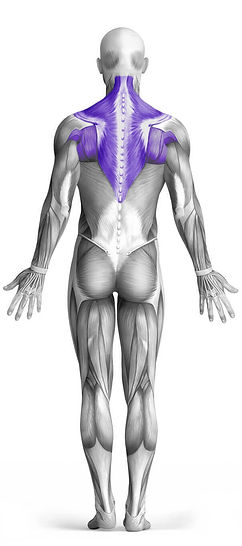Cable Decline Seated Wide-Grip Row 101 Video Tutorial
0

Exercise Synopsis
Target Muscle Group
Upper Back
Execution
Compound
Force Type
Pull
Required Equipment
Cable Machine
Fitness Level
Advanced
Variations
Alternatives
Timer
Hour
Minute
Second
Stopwatch
00:00:00:00
Overview
The Cable Decline Seated Wide-Grip Row is an effective exercise designed to target the upper back, with secondary emphasis on the lats and biceps. Using a cable machine, this exercise involves a wide-grip handle, which helps engage the upper back muscles, including the traps and rhomboids, while the lats assist in the pulling motion. The biceps also play a supporting role, helping with the flexion of the arms during the row. This compound movement focuses on strengthening the back and improving posture, while also providing an excellent opportunity to activate and develop the biceps. The exercise requires a cable machine, making it an accessible choice for both beginner and advanced fitness routines.
How to Perform
Begin by adjusting a decline bench to face the cable machine.
Attach a wide-grip handle to the low pulley of the machine, ensuring it is secure.
Sit on the bench and place your feet firmly in front of you for stability.
Grasp the wide-grip handle with both hands, using an overhand grip that is slightly wider than shoulder-width.
Maintain a straight back, engage your core, and lean back slightly, fully extending your arms in front of you.
Initiate the movement by pulling the handle towards your abdomen, focusing on squeezing your shoulder blades together as you row.
At the peak of the motion, pause briefly, feeling the contraction in your upper back muscles.
Gradually return the handle to the starting position, allowing your arms to extend fully again.
Repeat the movement for the required number of repetitions, maintaining controlled and deliberate motion throughout.
Throughout the exercise, ensure steady breathing: exhale while pulling the handle towards your body and inhale as you return to the starting position.
★ Bonus: For exercises that involve external weights (such as dumbbells, barbells, or machines), the One Rep Max (1RM) calculator can help you estimate your maximum lifting capacity. Use it to track your strength progress and adjust your training for optimal results.
Tips
Ensure proper form during the entire movement to effectively engage the back muscles.
Gradually increase the weight to keep challenging your strength and making progress.
At the peak of the row, focus on squeezing your shoulder blades together to fully activate the back.
Complete a full range of motion by fully extending your arms at the start and pulling your elbows towards your sides during the row.
Keep your core tight and maintain a stable, upright posture throughout the exercise for optimal stability.
Control the movement carefully, avoiding momentum, to ensure the muscles are being worked correctly.
Hold your wrists in a neutral position to prevent any strain or discomfort during the pull.
Breathe steadily throughout the exercise, making sure not to hold your breath at any point.
If you're using a cable machine, adjust the pulley height to target different areas of the back and add variety to your routine.
Take your time with each rep, focusing on smooth, controlled movements rather than rushing through the sets.
How Not to Perform
Avoid Using Momentum: Do not jerk your body or use any swinging motions to pull the handle. Focus on controlled, smooth movements to prevent unnecessary energy wastage and to keep the emphasis on your back muscles.
Don’t Round Your Back: Keep your back straight throughout the movement. Rounding your back can lead to poor posture, unnecessary strain, and increase the risk of injury, especially in the lower back.
Don’t Overextend Your Arms: While it's important to extend your arms fully at the start, avoid overextending to the point where you lose control of the movement. This can decrease the effectiveness of the exercise and put strain on your shoulders.
Avoid Using Your Arms Too Much: Keep the focus on pulling with your back muscles, not your arms. If you feel your biceps doing too much work, adjust your form by engaging your back muscles more and reducing the reliance on your arms.
Don’t Rush Through Reps: Performing the exercise too quickly can lead to sloppy form and wasted energy. Focus on a deliberate pace, ensuring that each rep targets the right muscles and maximizes muscle engagement.
Don’t Arch Your Neck: Keep your head aligned with your spine. Arching your neck or looking up can strain your neck muscles and interfere with the flow of the exercise.
Avoid Using Too Much Weight: Using a weight that is too heavy can compromise your form and lead to poor muscle activation. Start with a manageable weight, focusing on technique, and gradually increase the load as you improve.
Don’t Let Your Elbows Flare Out: Keep your elbows close to your body as you pull the handle towards your abdomen. Flaring them out can shift the focus away from your upper back and lead to less efficient muscle recruitment.
Don’t Hold Your Breath: Remember to breathe continuously during the movement. Holding your breath can cause unnecessary tension and reduce oxygen flow, which is essential for maintaining endurance and muscle performance.
Avoid Using a Narrow Grip: A narrow grip can limit the engagement of the upper back. Ensure your hands are positioned slightly wider than shoulder-width to properly activate the target muscles.
Variations
Variations of fitness exercises refer to different ways of performing a specific exercise or movement to target various muscle groups, intensities, or goals. These variations aim to challenge the body differently, prevent plateaus, and cater to individuals with varying fitness levels.
Alternatives
Alternative exercises in fitness refer to different movements or activities that target similar muscle groups or serve the same training purpose as the primary exercise. These alternative exercises can be used as substitutes when the original exercise is unavailable or challenging to perform due to various reasons such as equipment limitations, injuries, or personal preferences.








